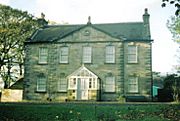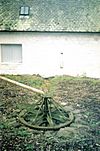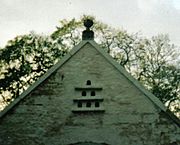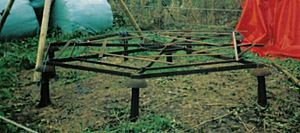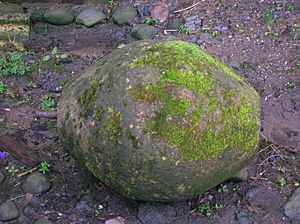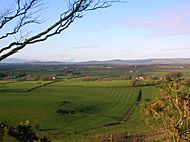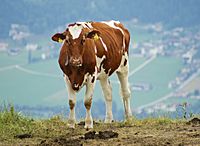National Museum of Rural Life facts for kids
The National Museum of Rural Life is a fantastic place to learn about farming and country life in Scotland. It used to be called the Museum of Scottish Country Life. You can find it at Wester Kittochside farm, located between East Kilbride and Carmunnock. National Museums Scotland looks after this museum.
How the Museum Started
The museum opened its doors in 2001. Many groups worked together to create it. These included the National Museums of Scotland and the National Trust for Scotland. They wanted to show what life was like on a Scottish farm.
The National Museum of Rural Life continued the work of an older museum. This was the Scottish Agricultural Museum, which started in 1949. The new museum is much bigger and has more to see.
Today, the museum has a large visitor centre. It also includes the old Georgian buildings of Wester Kittochside farm. You can explore the fields and hedgerows around it too. There is even a big area for special events.
The Reids: Farmers of Kittochside
The farm covers about 44 hectares (109 acres) of land. In 1992, Mrs. Margaret Reid gave the farm to the National Trust for Scotland. She had run the farm for many years with her husband, James. He was the last of ten generations of the Reid family.
The Reids were the "Lairds" (landowners) of Kittochside. They farmed this land for over 400 years, from 1567 to 1992.
The first Reid to own the land was John Reid in 1567. He bought it from Robert Mure. There was a disagreement over the land. The case went to court, and John Reid won. This allowed the Reids to build up their farm.
The Reids were also involved in important historical events. They fought against the king in the Battle of Bothwell Brig in 1679. James Reid bravely saved his parish flag during the battle. His brother John was captured but later returned to manage the farm.
The Laird's House
The beautiful Georgian house was built between 1782 and 1784. It was a grand home for the Laird. An addition was built in 1906, changing the inside. Electricity was added in the 1950s, replacing oil lamps. The inside of the house looks just as it did in the 1950s.
Some of the buildings have round decorations called finials on their roofs. These were popular at the time. People once believed they could stop witches from landing on the roof!
The house and farm are on a hill. Large trees protect them from the wind. A very old Sycamore tree is a famous landmark there.
Wester Kittochside Farm
Farm Buildings
The main farm buildings were built by John Reid between 1782 and 1784. Some parts stand on older foundations from the 1600s. The small cow shed was updated over the years. The corn barn still has its threshing floor. Here, workers used a flail by hand to separate grain. Later, machines powered by horses or engines did this work.
The 6th Laird of Kittochside also worked with quarrying and limestone. This meant they needed a stable for three horses. A large barn was built in 1949. The farm stopped dairy farming in 1980. They then raised beef cattle until 1992, when the National Trust for Scotland took over.
Horse Engine or Gin
The farm has a very rare working 'horse mill' or 'gin'. This machine was used to power other farm equipment. For example, it could run the winnowing machine in the corn barn. This machine helped remove the outer layer from grain. Before these machines, farmers used a flail. This was a wooden pole with a smaller pole attached by a chain.
Bothy
A "bothy" was a simple room for a single farm worker. The bothy at Wester Kittochside was used as a tack room for horse equipment. During the Second World War, it housed a German prisoner of war named Heinrich Luckel. He stayed in touch with the Reid family for many years after the war.
Doocot, Cart and Gig Sheds
Above the cart shed door is a "doocot" or pigeon house. Doocots were common on large country estates. They provided a year-round supply of meat. The Kittochside doocot is simple and practical. A lean-to shed for a "gig" (a light, two-wheeled cart) was added in the early 1800s.
Stathel
Wester Kittochside has two "stathels." These are cast-iron structures that look like large mushrooms. They are used to support stacks of hay or grain. This keeps the material dry and safe from rats and mice. The animals cannot climb up the smooth metal legs.
Whin Stone
In the farmyard, you can see a large oval stone with metal parts. This was a "whin stone." It was used to crush tough gorse plants. A horse would drag the stone back and forth in a shallow trough. This made the spiny gorse soft enough for animals to eat. It was usually only used when other food was scarce.
Field Names
The farm map from 1858 shows interesting field names. These include Buchans, Long Croft, and Greenlawford. These names tell us about the farm's history. You can learn more about them in the Laird's House. There is a special room about the Reid family and their farm.
Slip Gate
At the entrance to the Buchans field, you can see old "slip gate" posts. These gates did not have hinges. Instead, wooden bars slid into grooves in the stone posts. This created a simple gate. You can still find these types of gates in the countryside sometimes.
Rig and Furrow
The Buchans field has very clear "rig and furrow" marks. These are lines in the ground from old farming methods. Farmers would build up earth in long strips (rigs) with drains (furrows) on either side. This was how crops were grown before the 17th century. These marks show how farming has changed over time.
Archaeology
In 2005, volunteers explored the area around the farm. They found many old items. Most were from the 1800s, like pottery, glass, and clay pipes. They also found older things, like medieval pottery and flint. These items likely came from old farm waste spread on the fields.
Exhibition Building and Collections
The main Exhibition Building was designed to look like a modern barn. It has large sliding doors and white-washed walls. This design connects it to the world of farming and nature.
The museum focuses on three main ideas: land, tools, and people. Many items came from the old museum at Ingliston. Others were donated or bought. The displays show how people lived and worked the land in the past. They also explain how this shaped the countryside we see today. The museum also has items about farming folklore, like charms and special stones.
You can see many different exhibits. These include old farm tools, clothing, and household items. There is a very old reaping machine invented by Patrick Bell. You can also see an early iron plough by James Small. The museum has one of the best collections of combine harvesters in Europe. The High Breck of Rendall Mill is also on display. It is the oldest known surviving threshing mill in the world.
The museum also has many small models of farm machinery and water wheels.
Visitor Experience
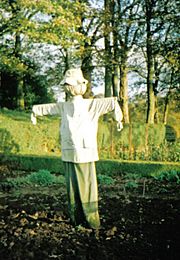
A visit to the National Museum of Rural Life lets you experience farm life from the 1950s. You can see how farmers used to plough, sow, make hay, and harvest. Guides help you understand all the activities of a Scottish farming year.
You can take a Tractor ride to the farm. There, you can see the special Ayrshire cattle herd. They are milked every day at 3:00 PM. You can also see the Scottish blackface sheep flock. They have lambs in early April.
The museum offers many events throughout the year. These include heavy horse shows, tractor shows, and sheepdog trials. There are also fun events like the Kittochside Fair and a Halloween Party. In 2019, over 113,000 people visited the museum.
Kittochglen and Philipshill Mill
Below the Exhibition Building is a valley called Kittochglen. The Kittoch Water flows through it. This water used to power a grain mill. The old mill cottage is still there. You can also see the weir (a small dam) that directed the water.
Education
The museum is a great place to learn about the countryside. It teaches about nature, the environment, and farming methods. You can learn about the long history of farming in Scotland. It also shows what life was like for people who lived and worked in the countryside.
See also
- Dalgarven Mill
- Staddle stones
- Dunlop cheese



